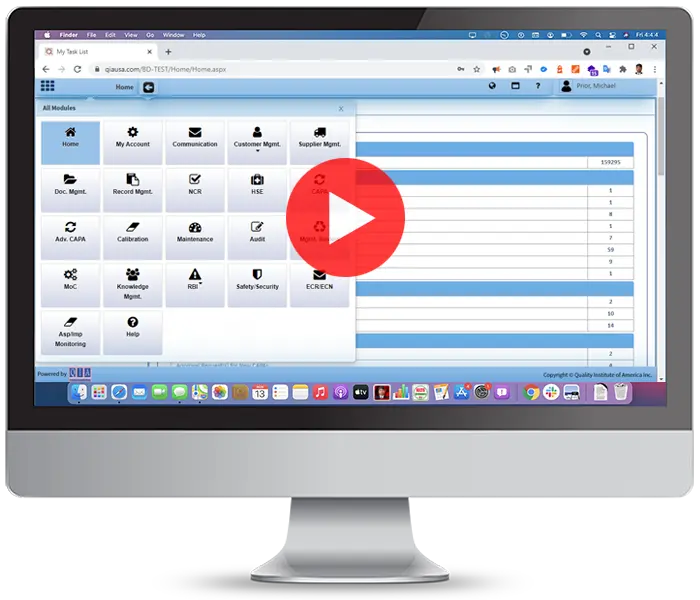QIA recommends the following modules for an effective environmental management system. All modules share a common theme of initiating tasks, follow Best Practice workflow, and help manage it through alerts, escalations. As tasks are done, records are generated and stored automatically, allowing for powerful analysis and reporting. Advanced searches are also available. Apart from the best practice fields already programmed in, custom forms with workflows can be created by you with ease. All modules are integrated with the others. Use of QISS assures water-tight compliance with standards, and auditors will be impressed.
QIA also offers professional, environmental management consulting services. A QIA client has at his disposal multiple professionals who possess the experience and knowledge on all aspects of environmental management. From PhD-level individuals to professional consultants with multiple years of experience, QIA can provide a client with the best advice and best practices needed for managing an environmental management system.

Environmental Management System Software
QISS was developed first for automating Environmental Management System Software (EMS). The initial standard supported was ISO 9001, arguably the base standard for all subsequent standards.
What is Environmental Management Systems Software?
Environmental Management Systems software or EMS, is an integrated system that include procedures and processes that:
- Provide the capability to initiate an impact process, with all associated data related to an event
- Provide the processes and data storage required for governmental reporting requirements
- Provide for documentation creation and storage
- Provide training of personnel
- Provide risk assessment technology related to reported events
- Provide non-conformance and corrective action modular systems to track and eliminate causes of future events
Why is it Important?
An organization that utilizes and Environmental Management Software benefits from two specific aspects:
- The ability to address and respond to its regulatory requirements in a systematic way -the system is provided by te software and its designated workflow processes
- Cost savings by using software versus a manual or hybrid process
Software allows the user to take a proactive approach to documenting and disposing of issues related to non-compliance with governmental regulations and aid in the improvement of health and safety processes and practices for an organization’s personnel and the public at-large.
How Environmental Management Systems Software can help an organization?
An Environmental Management Systems Software offers a digital framework that:
- Allows the user to create and manage the organization’s strategic operations related to environmental management issues
- Allows the user to create, document and implement an effective environmental policy that serves the overall interests of the organization and maintains operational excellence.
- With an Environmental Management Systems Software, an organization can determine the areas of importance related to meeting organizational and environmental, that can include:
- Waste management
- Processing of required data and storage requirements
- Reduction of carbon and other emissions
Features of QISS Environmental Management Systems Software
- Environmental Policy
- Should reflect the environmental ideals/direction of an organization
- Allows the organization to ensure compliance with regulatory requirements
- Environmental Requirements and Voluntary Initiatives
- Understanding of regulatory requirements and their effect on an organization’s EMS
- Identify practices related to management and manufacturing that may affect an organization’s EMS
- Objectives
- Should be specific to an organization’s overall purpose
- Seek compliance with regulatory requirements
- Prevention of environmental impacts (pollution/accidents)
- Structure, Responsibility and Resources
- Availability of personnel
- Availability of needed materials
- Define management responsibilities
- Manage and monitor objective performance
- Operational Control
- Organizational procedures/instructions for management and oversight
- Corrective and Preventive Action and Emergency Procedures
- Develop and maintain procedure(s) for error identification, correction, and preventative actions
- Document all actions taken
- Training, Awareness and Competence
- Roles and responsibilities of personnel defined
- Determine required trainings related to job descriptions and processes
- Organizational Planning
- Determine affect products have on environment and monitor for “life-cycle”
- Training of personnel to identify and aid in elimination of environmental hazards/issues
- Document Control
- Procedures related to inspections, data management, record management
- Document all impacts/issues related to environmental processes
- Continual Improvement
- Document improvement action items
- Monitor performance based upon improvement actions
- Perform necessary audits to determine effectiveness of EMS
- Always monitor objectives as they relate to process performances
Benefits of QISS Environmental Management Systems Software
Running an effective Environmental Management Systems Software will help your organization with:
Costs of managing the overall system and improving overall efficiency of an organization’s Environmental Management System. Other benefits include the ability to:
- Manage Processes
- Create and maintain procedures that define and identify required reporting and data recording
- Maintain and protect data
- Delegate responsibility and drive accountability
- Workflow that assigns and monitors tasks and escalates if task performance is late
- Competence training of personnel to manage processes and reporting requirements
- Measure, monitor, and analyze program performance
- Track and store all relevant and required data
- Use of dashboards for quick and precise data retrieval
- Allows for use of trending analysis
- Save time and money
- Software is efficient and fast compared to a manual or non-dedicated environmental systems software
- Assign and monitor tasks more efficiently
- Reduce compliance risk
- Software can reduce risk exposure
- Can provide “peace of mind”
